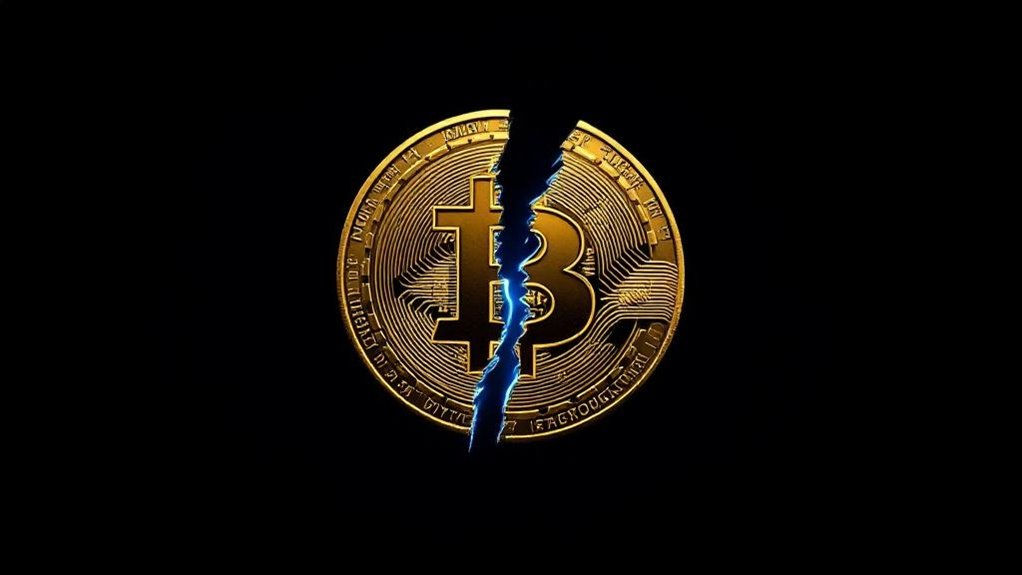Cryptocurrency halving slashes mining rewards in half at fixed intervals, keeping digital currencies like Bitcoin scarce and potentially valuable. For Bitcoin, this automated pay cut happens every 210,000 blocks (roughly four years), dropping from the initial 50 BTC per block to today’s 6.25 BTC. It’s a digital diet plan – limiting the money supply to a strict 21 million coins total. The next halving hits in 2024, and smart investors are already watching the clock.

How does a cryptocurrency protocol keep its money supply in check?
Through a fascinating mechanism called halving – and it’s exactly what it sounds like.
The rewards that miners receive for processing transactions get slashed in half at predetermined intervals.
It’s like clockwork, except instead of hours passing, it’s blocks being mined.
Take Bitcoin, the poster child of cryptocurrency.
Bitcoin leads the crypto pack, showing the world how digital currency can redefine money as we know it.
A vast network of over 56,000 nodes works together to maintain this system.
Every 210,000 blocks (roughly four years), something dramatic happens.
The mining reward gets cut in half.
No meetings, no debates, no central bank decisions.
Just cold, hard code doing its thing.
What started as 50 bitcoins per block has dropped to 6.25 today, and in 2024, it’ll become 3.125.
Math is ruthless that way.
This isn’t just some arbitrary digital diet plan.
Halving serves a vital purpose: keeping cryptocurrency scarce and valuable.
Bitcoin’s total supply will never exceed 21 million coins – period.
It’s like digital gold, except you actually know exactly how much exists and how much will ever exist.
Try getting that kind of transparency with precious metals.
For miners, halving is about as welcome as a pay cut – because that’s basically what it is.
They’re doing the same work but getting half the rewards.
Some miners can’t handle the heat and drop out.
Others double down on efficiency, investing in better equipment or finding cheaper energy sources.
The first major drop occurred when the initial 50 BTC reward was cut in half on November 28, 2012.
Darwin would be proud; it’s survival of the fittest in the digital age.
The market gets pretty worked up about these events.
Historically, halvings have preceded price increases, though correlation doesn’t equal causation (shocking, right?).
It’s simple economics: less new supply hitting the market while demand stays constant or grows.
The whole thing creates a fascinating economic experiment – a predictable supply reduction in an unpredictable market.
Think of halving as cryptocurrency’s built-in resistance to inflation.
While traditional currencies can be printed at will, crypto follows its own strict diet plan.
No midnight snacks, no cheat days, just programmed scarcity working its magic.
This automated protocol ensures network security by maintaining a delicate balance between miner incentives and controlled inflation.
Frequently Asked Questions
How Does Cryptocurrency Halving Affect Mining Profitability?
Halving slashes miners’ income overnight – brutal but true.
Block rewards get cut in half, instantly reducing the bitcoin they earn. Ouch.
Unless crypto prices surge to compensate, profit margins take a serious hit.
Smaller miners often can’t survive the squeeze and shut down.
The big players? They adapt by upgrading equipment and finding cheaper energy sources.
Some actually thrive by scooping up discounted mining rigs from those who throw in the towel.
Can Halving Trigger a Crypto Market Crash?
While halving itself doesn’t directly cause market crashes, it can amplify existing market volatility.
Short-term price swings? Sure.
But history shows no halving has triggered a genuine crash.
The real risks come from miners potentially dumping coins to cover costs, or market speculation getting out of hand.
External factors like economic conditions or regulatory changes pack more punch when it comes to crash potential.
Halving’s just one piece of a bigger puzzle.
Which Cryptocurrencies Besides Bitcoin Undergo Halving Events?
Several major cryptocurrencies follow Bitcoin’s halving tradition.
Litecoin cuts its block rewards every 840,000 blocks – most recently dropping from 12.5 to 6.25 LTC in August 2023. Bitcoin Cash mirrors Bitcoin’s exact schedule, currently at 6.25 BCH per block.
Dash does its own thing every 210,240 blocks, now giving miners about 2.68 DASH. Even Ethereum Classic has jumped on the bandwagon with periodic reward reductions.
Everyone wants to be like Bitcoin, apparently.
How Do Traders Prepare for Upcoming Halving Events?
Traders get pretty methodical about halving prep.
They track block heights obsessively, study historical patterns from past halvings, and start positioning months in advance.
Some stockpile Bitcoin early, while others play it safe with stop-loss orders.
The smart ones delve into on-chain metrics, monitor mining data, and watch social sentiment like hawks.
Technical analysis tools? You bet. And yeah, derivatives come into play for those feeling extra spicy.
What Happens to Transaction Fees During and After Halving?
Transaction fees typically surge during and after halving events.
Here’s why: miners get fewer coins as rewards, so they prioritize transactions with higher fees to stay profitable.
Users end up competing harder to get their transactions processed quickly. Simple economics.
Sometimes fees spike dramatically in the initial post-halving period.
Eventually, the market usually finds a new equilibrium – but those fees rarely return to pre-halving levels. That’s just how it goes.









